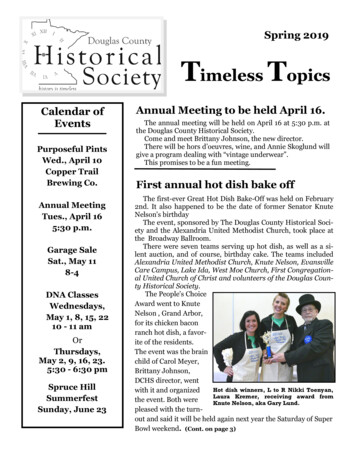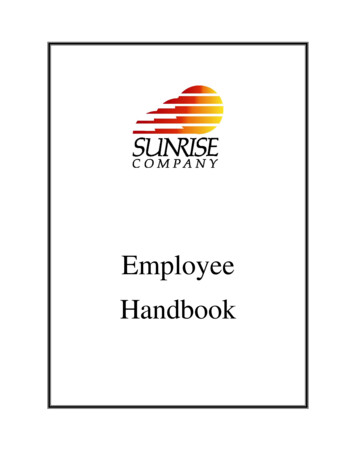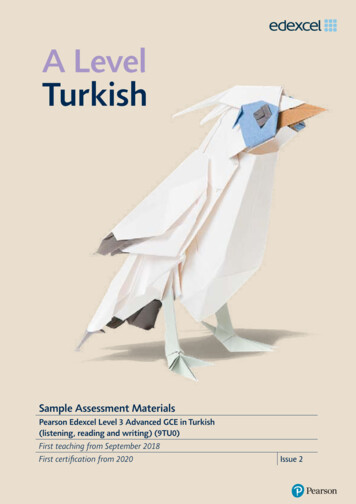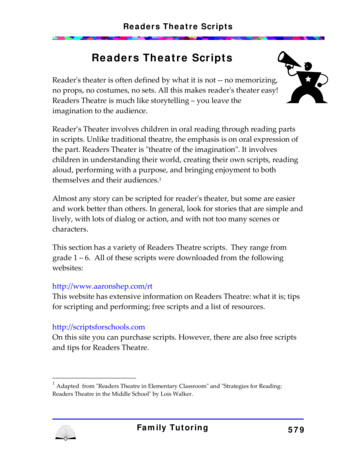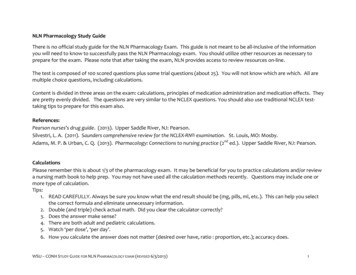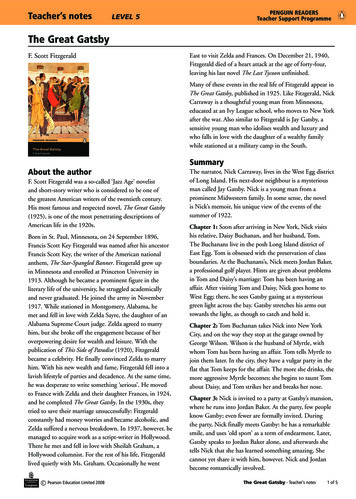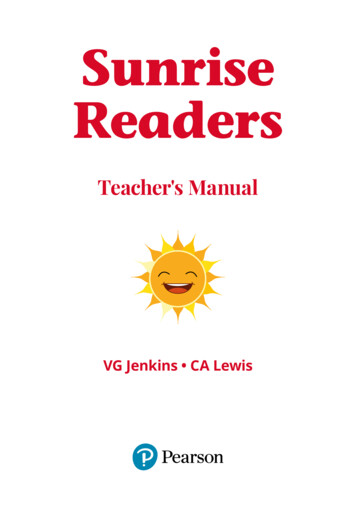
Transcription
SunriseReadersTeacher's ManualVG Jenkins CA Lewis
ContentsPreface: The Sunrise Readers Reading SchemeIntroduction 1Brain development and reading readiness 1Pre-reading 2Teacher preparation 4Practical suggestions for teaching reading 6Games 10The teacher’s reading record 13Phonics and reading 14A suggested progression for the teaching of phonics 15Phonics games 19How to introduce learners to new reading books 21Phonics sounds and clue words 22Book 1: Friends 24Book 2: Work and Play 28Book 3: Home and School 32Book 4: Story Time 35Book 5: We Come and Go 38
The Sunrise ReadersReading SchemeThis Teacher’s Manual lays the foundation and establishes methodsfor the approach to the teaching of reading that will be consolidatedthroughout the Sunrise Readers Reading Scheme.By the time learners have completed Sunrise Readers Book 5, a verybasic foundation for reading will have been laid. The Look and say andWhole sentence approaches to teaching reading will be giving way tothe thorough and systematic teaching of phonics, which has beenhappening alongside. Children will still be introduced to sight wordsas laid out in this manual, but – if teachers have applied themselvesefficiently to teaching phonics alongside word recognition skills –children will now be able to sound out and break down many words forthemselves.The popular Do This comprehension exercises are introduced fromBook 6. Along with giving children essential practice, these exercisesprovide teachers with simple, useful assessments of the children’sunderstanding/comprehension of each story and of the vocabularyintroduced. They also provide practice of phonic skills encountered ineach story. Simple Do This exercises and teacher tips for Books 1–5 areavailable, along with other valuable resources, on our website.The Sunrise Readers Reading Scheme consists of the revised SunriseReaders books 1–10, and the original books 11–20, followed by theSunrise Readers Blue and Red books for later grades. The samepattern outlined in this manual can be followed throughout. Themethod laid out in this manual for introducing and surveying each newbook as it is issued to the learners should be used for each new book.“The Sunrise Readers have established a culture of reading in ourcountry.”Grade Two teacher in ZimbabweWhat is a reading scheme?A reading scheme consists of a series of books that have have beencarefully compiled to help learners learn to read and develop their readingskills.
IntroductionThis manual is intended as an essentially practical companion for thereading scheme. It does not set out to expound the philosophy orpsychology of reading, but is an aid for grades 1 and 2 teachers in theteaching of reading. It is meant specifically for use with the readingscheme.The ideas and suggestions that follow arise from many years ofpractical experience. They are given as a seed to be developed and builtupon as suits each individual teacher.Brain development andreading readinessIn recent years, there have been major advances in understanding theimportance of brain development in children. Children of the samechronological age will show wide variations in their readiness to startlearning to read. The developmental stages in the brain must occurbefore a child is able to cope with reading tasks. Teachers shouldbeware of labelling a child’s intelligence when, in fact, his/her brain isstill maturing.Teachers who are aware of early childhood development will enrich thelearning environment (inside or outside the classroom) and so enhancethe opportunities for brain development. Making use of pre-readingactivities, paying close attention to how each child manages in the classenvironment and looking out for “reading readiness” indicators willenable the teacher to tailor the reading programme to suit the child.Activities that involve whole body movement are vital: marching –opposite arm to opposite leg; climbing that involves pulling and pushingthe body; obstacle courses where a child has to solve problems; tomove over, under and through obstacles, and to engage whole-brainthinking.1
Pre-readingPre-reading and pre-formal learning activities are essential. The timespent on these activities will vary from class to class but it is advisablefor all children to be exposed to these activities as a period of readinesstraining. The teacher must view this time as a valuable investment inthe children and not as a series of time-filling exercises.Not only is this an important time for the children, but the teacher hasan opportunity for careful observation. The teacher should attemptto get to know the children as individuals. During this time and shouldnotice such points as whether the child has established a preferredhand.All the games and exercises should be designed to help the teacherdiscover more about the child’s level of development. Somefundamental suggestions follow but many more activities arecompetently covered in excellent resource books and on the internet.1: Left-to-rightThese should aim to co-ordinate eye-hand movements and enable thechild easily to cross her hand from one side of her body to the otherwithout changing hands.In the example above, the child would be told to put his crayon on theworm and to draw a path for the worm to go to the cabbage. Cardssuch as this could be laminated. The child then uses a felt-tip pen whichcan be wiped off with a damp cloth. In this way, the cards are reusable.Another alternative is to give each child his own duplicated sheet withfour to five examples on a page.2
Other ideas are: a train going into a tunnel a butterfly flying to a flower a bird flying to her nest.2: Visual discriminationThis is an essential skill when using the Whole word or Look and sayapproach to teaching reading.a)The child should be able to distinguish small differences in shapes,pictures and patterns. From a row of similar pictures, she shouldbe able to pick the odd one out.b)Using the same skills, the child should be able to identify two thatare identical.3: Visual memoryThis skill can be trained by showing a simple shape, such as these shownabove, for a short time and asking the child to draw it when it is removed.Kim’s Game also aids memory: A small selection of objects ispresented to the children. The children close their eyes and one objectis removed. The children are called upon to recall what is missing.Alternatively, an extra object can be added to the selection. Thechildren then identify this.3
Of necessity, much of this work is done orally on a class level. This is anopportunity for the teacher to establish the child’s level of understanding,development and use of language, and level of vocabulary. Any majorspeech or hearing disorders may be detected at this time.Teachers! Try this for fun!You will be reminded how difficult the process of learning toread is for our young learners. (Do not try this with your class.) Thisis an example of how complicated text might appear to a child who isencountering text for the first time.Th ca sa o th ma .It makes no sense and many of the symbols look similar, or arereversals of each other (In our alphabet, for example a child needs tobe able to swiftly distinguish between letters such as d and b : db, or qand p : qp, then numerals add to the confusion : 6 and 9 : 69, or 2 and 5: 25.)The text above is revealed to be –Th ca sa o th Thecatsatonthema .mat.Teacher preparationWhilst preparing the children for reading, the teacher must be verywell prepared for the time when the children begin actually learning toread text. In classes where the children have attended nursery schools,many of the pre-reading activities mentioned above will have beencovered. Thus, these children will be ready to begin reading earlier thanthose without such exposure.14The teacher is the key to how the class will respond to reading. It isvital that she be excited and enthusiastic about reading, andthat she infuse the children with the same enthusiasm for readingand books. We also cannot over-emphasise the importance ofadults reading to children from the earliest age.
2Practical preparation can be time-consuming but the value of thetime invested cannot be overestimated.At this early stage in reading, each picture tells a story. The child will notpick up much from the text alone. The teacher should be familiar with allthe picture stories in Book 1 and at least the first few in Book 2. Whenteaching the words, the teacher must tell the story shown in the pictures.At these times, as much attention to detail and humour as possibleshould be injected into the story telling. This is the teacher’s opportunityto bring the Sunrise children to life as she introduces them to herlearners.During discussions of the pictures, the teacher will be able to develop asense of anticipation in the children. Through simple questioning, shecan help the child to understand what has already happened by whathe sees. In the same way, she can teach him to anticipate what mighthappen next. e.g.: When using the picture of David’s boat on Page 6, theteacher might ask, “What do you notice about David’s boat?” “What doyou think will happen next?” “Why do you think that?” etc.3Basic equipment must be ready before the children are. Flashcardsmust be made for each word in the book. Teachers will need tomake their own flashcards. Some words look completely differentwhen using a capital letter. Such words need a separate flash cardshowing the word with a capital. e.g. go Go; down Down.Each card should be about 25 cm x 7 cm. These can be neatlystored in a shoe box, with dividers to keep words from other booksgetting muddled.4Sentence strips need to be made for practising the words. The firstthree books should be prepared in this way. The strips must usesentences from the books, or the teacher can make up her ownsimple sentences using the words from the book.See David and Tatenda run.5Come and find my Fluff.Build up a selection of games. Ideas for these will be detailed later.5
Practical suggestions forteaching readingFor the convenience of the teacher, each Sunrise Reader has a wordlist at the back. This list gives all the words that are introduced forthe first time. The teacher can build up her collection of flash cardsfrom these lists. Once the class has embarked upon the pre-reading program, theteacher can begin introducing reading words using the Whole wordor Look and say approach. At this point the child does not have thephonic knowledge necessary to sound out words. This will developalongside and will soon take preference over Look and say. The characters and the stories are introduced and discussed. Thechildren learn the Sunrise characters’ names and identify themvisually before reading the books. The first words (see the word list at the back of the book) could beintroduced at the end of the first week of school, depending on theteacher’s assessment of the children’s readiness. Only one or two words should be introduced each day. These mustbe reviewed and drilled daily along with each new one added.‘Drilling’ involves daily repetition and the children may be asked torepeat the word three times whenever the flashcard is held up. Thegames and suggestions following also contribute towards effectivedrilling. The best learning occurs when new work is practised littleand often, for example, at every lesson change over, before goingout for break, and before home time – run through the day’s wordsagain. Use ‘action words’ like go/jump/run/come or take the childrenoutside, show the flashcard and let them run; blow a whistle andchange the flashcard/command word to jump; blow the whistle,change the flashcard/command word to come, etc.How to introduce a wordThe teacher introduces the first word with a flash card. She tells thechildren what it says, for example, “This word says ‘look’. Look. Can yousay ‘look’? What do we look with? Yes, our eyes. Can you see these tworound eyes looking at you here?” (Points to oo in the word). She candraw two eyes into the word on the chalkboard.6
It is very useful if the teacher can devise as many ‘memory hooks’ aspossible for the words. The use of finger play also serves as a memoryaid. For example, the children can ‘look’ through the circle made bytheir thumb and forefinger, repeating ‘look’ over and over.Some other suggestions: Oh – a round mouth, children make their mouth round when theysay “oh”. On the board, the teacher can write the word and then show a face. come – make a beckoning finger in the shape of ‘c’. up/down – a see-sawohupdownand – a friendly word that joins people and things together. Get thechildren to hold hands, place the ‘and’ card above their hands.7
andThen a sentence strip using the word is read to the children, whorepeat it, for example:Tatenda and DavidActivities to help reinforce the words can be introduced as games.For example: matching the flashcard to the words in the sentence strip.ChipoChipoOh DavidOhDavid matching the flashcard (especially for the characters’ names) to thecorrect picture. Using the flash card with the new word, the teacher can hide itamongst four or five other words. The children have to hunt for theword. They whisper the other words but when they see the wordthey are hunting, they call it out and shoot a hand into the air.The words and sentence strips can be drilled as a class. Vary this: justthe boys saying the words, then just the girls, or individuals called uponto read alone.8
Practical organisation of the daily reading (which must be done witheach child) begins once 4 or 5 words are known. A suggestion for thisfollows: Set aside two soap boxes for each child with her name on each box.One is to stay at school. The second box is to be taken home andreturned to school daily. It can be decorated with a small picture. The teacher has duplicated a set of small word flash cards andsentence strips. These are put in the soap box that stays at school.As a child recognises a word, she takes home the sentence stripand words in her home box and these should be practised with theparents. Once all the words for Book 1 have been learnt, the child takeshome the book. This should have a marker with the child’s name onone side. On the other side there should be a partition for the pagesset daily and a space for the parent’s initials, signifying that thereading was practised at home. New pages are read to the teacherfirst and then practised at home.PaulPages SignBook 11–56–10 At this point, while the children are reading Book 1 at school and athome, words for Book 2 are introduced. When Book 3 is introduced, the teacher stops using the soap boxeswith small flashcards and sentence strips. Instead, the childrenprogress to word lists for home practice. These are duplicated andstuck into small notebooks (A6 size). Each list should have 4 or 5words on it. This may increase towards the end of the year. At thispoint, the children are able to learn three or four new words eachday. It is practical and convenient to keep the children a book aheadon words. This means they can progress to the new book as soon asthey complete the old.9
GamesChildren must be taught how to use the games. Unless they are toldthat these are precious items that took the teacher many hours tomake, they will not appreciate their value! The time taken to teach themto use the games properly at the outset is well spent. At a later date,when the class is more distinctly grouped into abilities, the children areable to use the games without supervision.1: Stepping stonesUse the flash cards already made or make cardboard outlines of stoneswith the words written on them. The flash cards are spaced out acrossthe floor with enough space between each for a child to stand.Tell the children a story of the situation – they are walking in a fieldwhen they come to a stream. The only way across is by stepping on the‘stones’. But the stones are slippery. If they can read the word they aresafe, but if they cannot, they slip off into the water!The teacher makes sure that the child is certain of the word he didnot know before he has to sit out of the game. (Ensure that childrenwho are “out” watch the others play so that they are still learning.) Theteacher may want to group those children who made errors so that shecan have an intensive time of revision with them. Those children whocross safely should receive applause from the rest or be given someform of praise and reward. Make the games fun!2: FishingCut outlines of fish sufficient for each word and for those needingcapital letter practice. If possible, use coloured cards or paint the fishand laminate them. Write one word on the back of each fish. Make alarge painted fishpond from a sheet of card.The fish are placed word-down on the pond. The children take turns tochoose a fish. If they can read the word, they hold the fish. If not, oncethe word is told to them and they repeat it, they replace the word (fish)on the pond.10
3: Apple treeCut outlines of apples or any fruit from coloured card, sufficient foreach word, as well as those needing capital letters. Paint or make alarge tree. The apples are stuck to the tree with stickistuff, with thecoloured side facing the children and the word hidden against the tree.The children choose an apple. If they can read the word, they hold it (orput it in a basket or give it to the teacher.) If not, the apple must go backon the tree. Vary this game by using bananas, oranges, lemons, etc.An example of simple fruit templates.11
4: Party balloonsUse a large picture of a child or a friendly-looking animal. In one handshe holds a lot of strings which are attached to coloured balloons. Eachballoon has a word on the back. The game is played in the same way asthe apple-tree game.5: The squirrelPaste a picture of a squirrel (it could be any relevant animal) ontoboard. Have a large supply of cardboard fruit, acorns or nuts. A smallcup is placed next to the squirrel. If the child can read a word from aflashcard, he can put a fruit, acorn or nut into the cup.12
6: Clothes lineFold coloured paper in half and cut out the shapes of clothing. Put oneword on each. These are hung by the fold on a string ‘clothes line’. If thechild can read the word, she can take the clothing off the line.Note:Teachers, please note that wherever possible, make sure the childsucceeds with these games. The game is supposed to be a funreinforcement and if the child never gets to keep his fish or apple, hewill be discouraged.The games can be used in reverse, for example, the teacher hands outan apple and the child reads it and sticks it back onto the tree.All these games can be adapted for use with phonic and number work.A phonic rule or number bond can be put on the back of the outlines.The children hold these if the correct answer is given. A fruit is fed tothe animal if the child recognises a phonic rule, etc.The teacher’s readingrecordThe aim of this document is to keep track of which book each child inthe class is reading. At any time, the teacher should be able to pinpointexactly where each child is. Ideally, the Grade One or Two teachershould aim to listen to each child read at least twice a week. This cantake a long time. To make this easier, an efficient record should becompiled before the children are issued with their books. This recordshould help the teacher, not be a complication. It should show the13
necessary information and not be cumbersome. If the reading recordis kept in a maths exercise book, from the second page, cut away themargin and first square of the remaining pages. In the left-hand marginon the first page list all the children by name.At the top of the page write the title: Book 1. Then the book is sectionedinto convenient reading units by page numbers. This is done for eachbook following.Each day, the teacher ticks off the next section of the reading set foreach child. Later in the year, some children may read two or threesections a day, depending on their ability. The teacher may choose towrite the date instead of ticking off each section.Book onics and ReadingPhonics is the teaching of the sounds of letters and groups of letters.The Look and say or Whole word approach to teaching readinghas been recommended to start the children on their readingjourney. However, this method alone will not equip the child for theworld of books. The systematic teaching of phonics is essentialto the process of learning to read. A child can only retain a limitedamount of sight words before her phonic skills need to take over andenable her to decipher new words.In order to tackle unfamiliar words, a child must be able to associatethe sound of a letter with a printed symbol. Thus the teaching ofphonics is vital. We recommend that teachers diligently follow a triedand proven phonics scheme.14
A suggested progression forthe teaching of phonicsThere are many excellent sources on the teaching of phonics whichare available to the teacher. The following is a skeleton outline foran approach to phonics. Details, methods and ideas are left for theteacher to fill in. This is given more as a guide to the phonic skills a childshould have mastered by the end of Grade Three.There are six basic steps in the teaching of phonics.1: Learning to recognise vowelsChildren readily learn that the letters a e i o u are called vowels. Allletters should be introduced with a picture association.AaEeappleelephantVowels have a short sound and a long sound. The short sound isintroduced first. Phonetic marking for the short and long sounds can beused at this stage. They help the child identify the sound and promotecorrect pronunciation.Short soundLong soundă - appleā - acorně - eggē - eagle15
2: Learning to recognise consonantsWhen the children are familiar with the vowels, they can learn that allthe other letters in the alphabet are called consonants. Again, flashcards and charts with a picture association must be used, having theconsonant as the first sound.Examples: f - fish, g - goat, h - hippoFfGgfishgoatHhhippoThe one exception is ‘x’ because it says the sound of ‘z’ as an initialconsonant, for example, xylophone.The letter ‘x’ represents a ‘diphone’ – one letter makes 2 sounds “k-s” asin “box”.The children can be taught to say ‘ex says ks’ and to find the lettersaying the correct sound at the end of words e.g. fox box.3: Learning to blend two letters togetherThe first blends children should tackle should be a consonant andvowel blend. Each consonant in turn is blended with each vowel. Thesecan be displayed as a step ladder.babebibobu16cakekicocu
(c and k share a ladder because ‘c’ says ‘s’ with ‘e’ and ‘i’. e.g. celebratecity)Children can be encouraged to find the initial blend and words theyalready know from their readers, for example, Je – Jenny and their ownnames such as Da-niel and Be-tty.As their knowledge increases, they can break down and build up manyknown words.4: Learning to sound out one-vowel or cvcwords (consonant, vowel, consonant) By using their blends, the children can begin to sound out simplewords.Examples: ba-t, be-t, bi-t Now the children can learn rules off by heart. These will help themto unlock new words. Rule: When there is one vowel in a word it usually says its shortsound. Final consonants are added to the blends to make thesesimple one-vowel words.Examples: ma-n, me-t, mi-ss, mo-p, mu-d The first letters to use as final consonants should be: b, d, f, l, g, m, p,s, t. Rule: When two of the same consonant stand together, they saytheir sound once.Examples: giggle, rabbit, pillow, bubble5: Learning to sound out two-vowel wordsRule: When there are two vowels in a word, the first one usually saysits long sound and the second one is silent.This rule covers many concepts, such as ’fairy e’ or silent e on the endof a word.Examples: māde, trāin, rōad17
In practising these skills (Points 4 and 5), the children should be able toidentify the following facts about a word:a)How many vowels in the word?b)Will the vowel have a long or short vowel marking?c)How should the word be pronounced?e.g. lǎck lākebǎck bāke6: Learning to sound out consonant blendsExplain to the children that a consonant blend is two or moreconsonants blended together in pronouncing a word. Each blendshould have specific rule and clue word with an associated picture. Thisacts as a memory hook for the child. His memory can be prompted bysaying, ‘It is spelt like sh in ship.’shipChildren need more than daily revision of this rule. They need to learnto apply it to other words using the same rule: e.g. shop, ship, shout.With practice like this, they will quickly learn how to sound out new words.18
An alphabetical list of the rules and suggestions for clue words is givenat the end of this section. The rules need to be thoroughly drilled sothat the children have learned them by heart. The spelling of the blendscan be taught from the end of Grade 1.Example: s-p-r says spr in spray.Phonics gamesThe learning of these rules must be made fun for the children. Thegames suggested for reading can be adapted for use with phonic rules.a)A blend can be written on to a cut-out template. The child has toidentify the blend and give the clue word.b)Words using the rules are written on two or more cut-out templates(e.g. trip train tree). The child has to identify which rule is beingused (e.g. tr in tree). Team races can be arranged to practise the rules. The class issplit into teams. A 'race track' is drawn on the board. Each teamis represented on the ‘race track’ by a cut-out picture. As eachmember of the team says a rule correctly, their picture moves a stepforward. The chalkboard has a great part to play in phonic learning. Pass the chalkThe teacher writes two or more identical lists of words using therules she wants practised. The children are put into two or moreteams, one child for each word. The first child holds the chalk. Atthe signal go, the child must circle the rule or mark the vowels ofone word and pass the chalk to the next child in his team. The firstteam to finish the marking correctly wins, for example:snākesnǎ cksnail19
StaircaseThe teacher makes a cardboard crown. On the chalkboard she drawsa simple staircase, each step having a blend, rule, vowel or whateverneeds practice. On the top step she draws the crown. If a child canclimb all the way to the top by saying the rules correctly, the child says‘crown’ and wears the crown until the next child completes the climbsuccessfully.br grclslThe bridgeplglespltrThis operates in the same way as the staircase. True and false (Thumbs up!)The teacher says a rule, sometimes deliberately incorrectly. If it iscorrect, the children give a thumbs up sign. If it is wrong, they give‘thumbs down’ and one child is chosen to give the correct rule.20
How to introduce learners to new readingbooks Teach the children to take care of books (i.e. clean hands, no food,store in a safe place ,etc.) Before opening the book or starting to read, assist the reader,whether in a group or individually, to look at the book covers. Ask the children to study the outside covers and talk about whatthey observe. (They are likely to focus on the picture.) Explain theother features and give their correct names, for example, “This isthe title of the book. The words say ‘Work and play’. Can you guesswhat the stories in this book might be about?” “Here are the names of the authors. An author is a person whowrites books.” Allow the children to talk about what they think the book may beabout.21
Phonic sounds and clue wordsa – anta – bananaal – alsoal – talkair – hairang – clangar – carar – dollarar – warmarr – marryare – careau – sauceaugh – caughtaw – saway – day (ā)b – batbb – rabbitc – catck – duckk – kittenc – city (s)ch – churchch – choruscl – clapcr – crabd – dogdge – fudgedr – drumdd – laddere – bed (ĕ)e – me (ē)y – baby (ē)ea – leaf (ē)ea – bread (ĕ)22ea – steakear – earear – bearear – earth-ed – looked (t)– played (d)– wanted (id)eigh – eight (ā)er – verseerr – merryes – torchesest – highestew – flewew – fewey – key (ē)ey – obeyf – featherff – puffgh – cough (f)ph – phone (f)g – goatgg – eggg – giantge – cageh – hati – pig (ĭ)i – rhino (ī)ie – brownie (ē)igh – high (ī)ir – birdire – firey – fly (ī)y – crystal (ĭ)
j – jamwr – writek – kittens – snakess – dresssh – shipc – city (s)sion – televisionl – legll – fellle – crocodilem - manmm – hammermb – lambn – netng – kingn – pinkgn – gnawnn – sunnyo – pot (ŏ)o – go (ō)o – come (ŭ)oa – boat (ō)oi – coinoy – toyor – forkor – work (with w)wa – wash/swan(ŏ with w)ou – houseow – cowow – bowl (ō)ou – enough (ŭ)ough – thought (aw)oul – wouldp – playpp – puppyq – queen (c)t – taptt – littletain – mountaintch – match (ch)th – thickth – this (voiced)u – buso – glove (ŭ)ur – purseure – pictureoo – looku – bullv – vanve – fivew – waterwh – whaleu – quilt (w)y – fly (ī)y – baby (ē)y – crystal (ĭ)z – zerozz – buzzze – sneezese – hose (z)r – rain23
Sunrise ReadersFriendsBook 12424
How to use this bookWe suggest that you introduce the children to their new books in threeshort lessons over the period of the week before the children begin toread the book.When first issuing the child with her Sunrise Reader, teach the child tosurvey the book to gain information about it before starting to read it.This is excellent practice with all books.Session OneDraw the child’s attention to the front cover.Ask the children these questions. See this word? Do you know what it says? Friends. (Explain that thisis the title of the book.) If the title of the book is Friends, what do you think the stories willbe about? What are these names? (Explain that these are the authors of thebook.) Look at the picture.– Who do you see?– What are they doing?– Tell me about what else you see in this picture.– What do you think will happen next?Session TwoBack cover and summary of the
Phonics and reading 14 A suggested progression for the teaching of phonics 15 Phonics games 19 How to introduce learners to new reading books 21 Phonics sounds and clue words 22 Book 1: Friends 24 Book 2: Work and Play 28 Book 3: Home and
